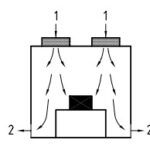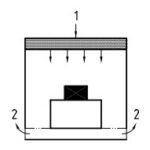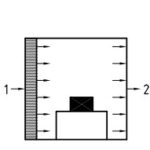

Testo finto finto finto testo testo
One of the main principles Clean Rooms are based on is air recirculation. It is essential to maintain the cleanliness requirements necessary inside the working environment. A Clean Room can be set up with various patterns of air flows depending on the various needs and/or peculiarities:


1. Turbulent air flow Clean Rooms
In case of turbulent flow Clean Rooms, a vortex air flow is introduced that mixes with internal air. Therefore, the input air mixes with that in the room diluting the suspended particles. The air therefore crosses the internal volumes of the Clean Room, exits from the wall air intake grills and is filtered again for a new cycle.
This type of flow is used in environments between the ISO 9 and ISO 6 classes. In order to pass from one ISO class to the next, it is necessary to intervene on filter quantity. This means that fewer filters are used in a class ISO 9 Clean Room compared to a class ISO 6 room. However, two different groups must be distinguished: group ISO 9/ISO 8 and group ISO 7/ISO 6.
A. Class ISO9/ISO8 turbulent flow Clean Rooms
As for Class ISO 9 and ISO 8 Clean Rooms, the absolute filters can be placed directly inside the centralised Ventilation Units, i.e. remotely, or directly on the suspended ceiling of the Clean Room, i.e. end position. Air is supplied through grids placed on the lower part of the walls or on the ceiling.
B. Class ISO7/ISO6 turbulent flow Clean Rooms
In this case, filtering modules are placed in end positions. Air is supplied through grids placed on the lower part of the walls.


2. Unidirectional air flow in Clean Rooms
In case of unidirectional “laminar” flow, the air flow does not have a vortex motion inside the Clean Room (as with the turbulent one), but it pushes the air uniformly from the top to the bottom according to what is called the “piston effect”.
A. Vertical Unidirectional flow Clean Rooms
The main characteristic of this type of Clean Rooms is that the filtering modules are installed on the suspended ceiling grid, covering between at least 80 and 100% of the surface. Such value is recommended by standard UNI EN ISO 14644. In most cases, air is supplied via a floating floor made up of perfectly-laid perforated tiles to guarantee the laminarity of the air flow.
B. Horizontal Unidirectional flow Clean Rooms
This last type of flow is typically used in operating rooms to protect patient beds or in the aerospace industry to protect the critical phases of satellite assembly. In this case, filtering modules are placed vertically on a Clean Room wall, while air supply grids are placed on the opposite wall to guarantee a horizontal flow of air.



